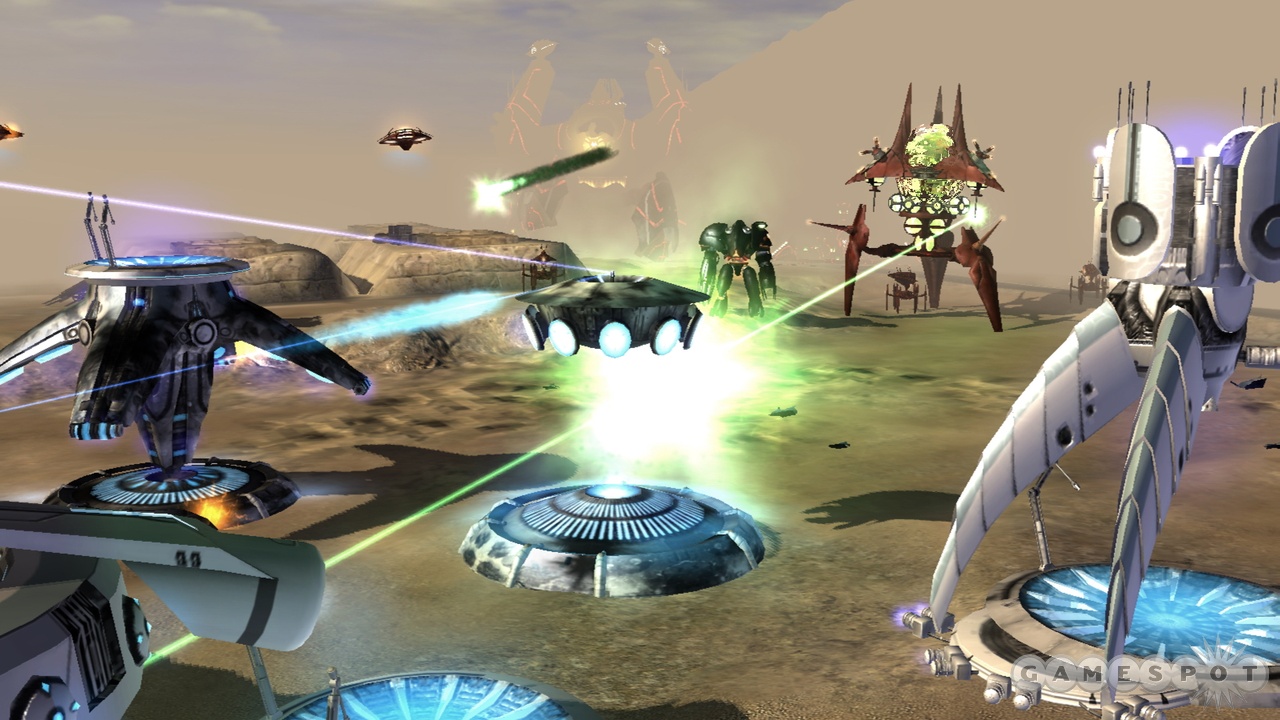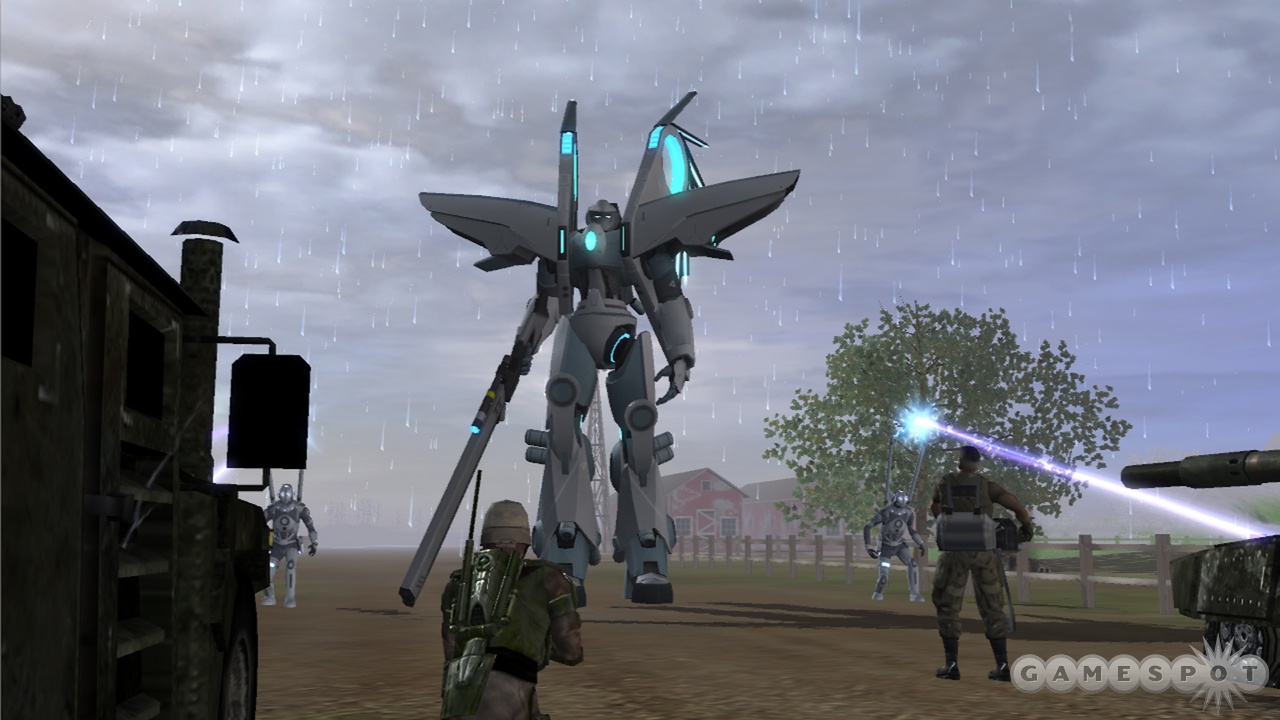Universe at War: Earth Assault Designer Diary #2 - Overview
Creative director Adam Isgreen discusses the new types of single-player and multiplayer game modes developed for this sci-fi real-time strategy game.
Sci-fi invasion stories tend to have a similar theme to them: Technologically advanced aliens arrive to wage war on Earth, only to be defeated by the plucky and resourceful human defenders. However, in Universe at War: Earth Assault, three technologically advanced alien races arrive on Earth, and humanity is pretty much going to be out of luck in the face of those odds. Universe at War is the second game from Petroglyph, the Las Vegas development studio founded by veterans of the team that created the landmark real-time strategy game Command & Conquer. Like Petroglyph's last game, Star Wars: Empire at War, Universe at War will feature a real-time strategic layer, where you can make global decisions, as well as a real-time battle system that lets you take command of armies and bases in the field. To introduce us to an overview of the different ways to play the game, in both single-player and multiplayer, we have the game's creative director. Universe at War ships later this year.

Earth in a Nutshell
By Adam IsgreenCreative Director, Petroglyph
Universe at War: Earth Assault is a real-time tactical and strategy game set on near-future Earth in the year 2012. Players take control of three very different factions and battle for control of Earth and the fate of humanity. In this designer diary, we'll be giving you an overview of the game, with information on our strategic and tactical modes, and some info on the online and offline game modes that you can expect to see in the finished product later this year.
Universe at War is divided into a tactical combat ground layer and a strategic global layer, each with its own unique gameplay considerations. From the global layer, you can view the entire planet, build territorial command centers, upgrade them with a number of technologies, launch devastating megaweapons, spy on opponents, and engage in offense, infiltration, and defense by utilizing your heroes and their persistent unit strike forces. Each of a faction's three heroes has their own abilities and powers in the strategic layer, and learning how to leverage their unique abilities is critical to your success. Of course, all this is happening in real time, so you have to constantly worry about what the enemy is doing as well!
When you get into a tactical battle in solo or multiplayer games, you're playing a full-blown real-time strategy game, complete with each faction's unique take on base building, resource collecting, scouting, combat, tactical dynamics, and research vectors. Research is really key to Universe at War, for depending on how you direct your research along each of a faction's three unique vectors, even the same faction facing itself in a mirror match can play very differently. Through the course of a normal solo or multiplayer game, you won't be able to get every single tech, either, so you're going to have to choose carefully and fully leverage the abilities and powers that you have unlocked in order to be successful.
Universe at War can be played in a number of different ways. Since we know that not everyone likes to play at the same speed, with the same game types, and under the same rule sets, we've provided a number of play options to suit all types of players in both online and offline modes.
When not playing online, the biggest part of the game is the story campaign, a linear experience that takes you from one end of the planet to the other over the course of 22 to 25 custom missions, depending on player choice. Through it, you'll get to play as the beaten-on human military forces, the Hierarchy, Novus, and our third playable faction, which has yet to be revealed. The finale cumulates in a final battle in which several races' futures hang in the balance, and not everyone will be back to fight another day. There's a lot of character drama in the story game, and although all these factions may be aliens, they have some very humanlike faults and failings, making their downfall or redemption that much more satisfying.
If you're looking for a more open-ended experience when you're offline, we also have conquest mode, where the path to victory is up to you. We present you with multiple open-ended scenarios (for example, conquer all of South America in 10 days) with a host of customization options (true hero death, tech limits, artificial intelligence opponent behavior, overall difficulty, and so on), and from there it's up to you to choose a faction and leverage both strategic and tactical modes to best effect in order to beat the scenarios set before you.
Of course, we also have a skirmish mode where you can play any map versus a number of CPU opponents in any configuration you wish in order to familiarize yourself with the factions, the territory maps, and each one's unique play-styles. Sometimes it's just fun to lay the smack down on the artificial intelligence or try out some new tactics and research choices that you don't want to risk using when playing in a more important situation, like during a critical ranked game!

When it comes to online modes, you can play classic multiplayer in either free-for-all or team modes with or without AI players, as well as utilize some of the specific new rule sets we're including, like DEFCON. In this game type, an ever-visible DEFCON stage indicator looms onscreen, just like in the classic movie WarGames. As the DEFCON level moves down every few minutes, every faction is advanced in tech along all research vectors automatically, raising the stakes dramatically as the minutes tick by. Do you time an attack to coincide perfectly with a tech increase or hit your opponents quickly before they get a tech that you really don't want them to have? Speed and tournament players will have a great time with this rule set, as your average game time is around 10 to 15 minutes before superweapons are on line and someone has been annihilated.
For those that want to take things at a less hectic pace, Universe at War has a conquer-the-world multiplayer mode, where you attempt to conquer the entire globe, one territory at a time. Win a multiplayer victory in a territory, and you hold it on the globe. Lose, and your opponent will take it from you, and you'll have to get it back. As you conquer more and more of the globe, the stakes increase for what you could lose, as does the difficulty of the opponents you'll face in matching. If you manage to conquer the globe, you can try to hold it as long as possible or move onto another globe and try to keep other players from completing their conquests. Players can play for 15 minutes or hours at a time as they try to increase their ranking and hold more territories without falling to an enemy. The pace is up to you, since your world won't get conquered if you're not participating in combat on it.
There's a lot more to talk about in every regard, but we hope this diary entry has given you an overall idea of what to expect when the game hits shelves at the end of this year. Come back each month as we reveal even more secrets about Universe at War: Earth Assault.
Got a news tip or want to contact us directly? Email news@gamespot.com
Join the conversation